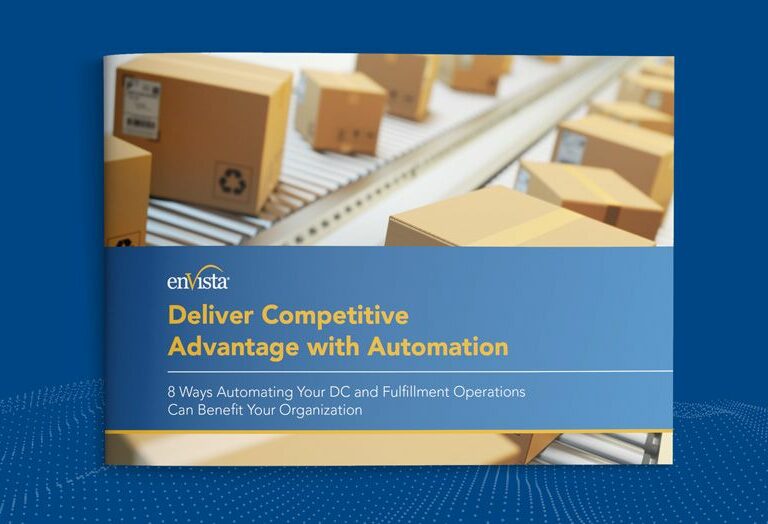In today’s highly automated environment, it is impossible to ignore the impact of technology on our daily lives and in the workplace across every industry. In the context of the disruption caused by the COVID-19 pandemic, it is worth examining potential methods for increased efficiency, process improvements and simple evolution in the supply chain. One of those methods is warehouse automation. In fact, many think that automation is the future of warehousing.
This is primarily because warehouse and distribution center automation bring efficiency and speed to the distribution chain, from the moment an order is placed to the point when the product is sent out for delivery. Understanding the benefits and adapting certain critical enhancements is a key approach to not only modernizing the way you do business but also driving long-term cost savings that make you a more valuable and trusted partner for your clients.
Table of contents
What Is Warehouse Automation?
An automated warehouse, using various types of automated technologies, can be a crucial supply chain solution that makes work easier to complete, conceptualize, manage and grow. The best warehouse automation definition is equally straightforward. Warehouse automation is a way of moving inventory into and through a warehouse with minimal human intervention. It is the result of targeted process automation in the realms of data collection, inventory control and your overarching warehouse management system (WMS).
Warehouse automation means the burden of your most manual, repetitive, tedious and potentially error-prone tasks can fall on the shoulders of increasingly accurate and fatigue-proof machines. This means the human touch can take place in the most highly visible, value-added areas. Once properly implemented, overhead will inevitably fall as cascading efficiencies are discovered throughout different elements of your bottom line. This is a true necessity considering today’s tight labor market and rising labor and fulfillment costs.
The endpoint to this would be an automated warehouse that maximizes warehouse space and the activity that occurs there, ultimately driving safer and more accurate warehouse processes in addition to higher employee engagement and customer satisfaction.



Deliver Competitive Advantage with Automation
Discover the eight operational considerations when determining whether automating your distribution center is right for your organization.
What Are the Types of Warehouse Automation?
There are two broad types of warehouse automation: digital automation and physical automation.
Digital Automation
Digital automation typically takes manual processes like inventory data collection and digitally automates them into your software system, such as a database or enterprise resource planning (ERP) system. This process automation can also be called warehouse automation software, digital process automation or system automation. Elements of digital automation can include:
- Tablets and smartphones
- Wireless barcode scanners
- Software and internet networks
- Cloud databases
- Machine learning algorithms
- Data analytics platforms
These solutions are generally lower cost options because they can be commonly understood as straightforward upgrades over an existing system for collecting and tracking inventory. Instead of tracking things manually, data is digitized. Once inventory arrives, you scan it into your WMS, where it can be tracked in real-time. This eliminates the potential for human error in multiple ways and it can be easily tracked or recalled, ensuring order fulfillment is accurate and timely. A similar result is the avoidance of stock depletion. An automated system can automatically reorder items once it hits a predefined threshold.
Physical Automation
Physical automation relates to equipment and machinery, i.e., robots and robotic systems. Physical automation is where a real transformation can happen, as opposed to a simpler upgrade.
Components of physical automation can include:
- Goods to person (GTP) technology
- Conveyor belts, carousels and vertical lift systems
- Material carrying vehicles, tote shuttles and mini-loaders
- Automated storage and retrieval systems (AS/RS)
- High-speed sorting equipment
- Warehouse robotics
- Driverless automatic guided vehicles (AGVs)
- Autonomous mobile robots (AMRs)
- Pick-to-light and put-to-light systems
- Voice picking and tasking
The sophistication of physical automation tools means that storage locations are using every square foot, vertically as well as horizontally, to their utmost ability. Advanced machinery can reach shelving unsafe for humans—further stretching capacity to another level. With improved space utilization, layout and workflow, the increase in productivity speaks for itself.
One measure of productivity measures revenue per square foot, which can help determine whether facilities are ready for the next step in implementing physical automation. A commitment to innovation along with a significant investment in physical automation for organizations can lead to the fully automated warehouse, where a dark warehouse is manned entirely by robots.
Common Types of Warehouse Technology
All warehouse automation technology has the end goal of speeding up processes, minimizing the number of manual tasks, and reducing errors. However, there are many types of warehouse automation technology on the market. Here are a few of the most common types of warehouse technology that can reduce costs and lead to increased productivity.
- Automatic Guide Vehicles (AGVs):
Automatic guided vehicles use magnetic strips or sensors to follow a set path through the warehouse. They are useful for larger non-complex warehouses. They are not helpful in complex warehouses with a lot of human workers/traffic.
- Autonomous Mobile Robots (AMRs):
AMR’s utilize GPS systems to find the most efficient routs through a warehouse. They employ laser guidance systems to avoid obstacles, which allows them to safely function in environments with human workers. AMR’s are simple to implement and program, making them a popular type of warehouse automation technology.
- Goods-to-Person (GTP):
Goods-to-person is one of the most popular types of warehouse technology, and it includes carousels, conveyers, and vertical lift systems. GTP systems are wonderful for lowering warehouse congestion and increasing overall efficacy. These systems have the potential to double or even triple warehouse picking speeds when properly implemented.
- Automated Storage and Retrieval Systems (AS/RS):
This form of GTP technology includes automated material handling systems and equipment such as tote shuttles, mini loaders, and material carrying vehicles. AS/RS technology allows warehouses to retrieve and store products more quickly with less space needed.
- Voice Picking and Tasking:
Voice directed warehouse technology (also referred to as “pick-by-voice”) utilizes speech recognition software to create pick paths through a warehouse and let warehouse workers know where to pick or place materials and products. This method is a good choice to improve picker efficiency and safety, as it removes the need for manual devices, such as RF scanners.
- Put-to-Light & Pick-to-Light Systems:
These systems employ mobile barcode scanning devices, which work with light displays to guide warehouse workers to the correct placing and picking locations. These systems tend to reduce human error and the number of worker hours needed to complete tasks.
How Do You Automate a Warehouse?
The right warehouse automation solution depends on your specific objectives and cost commitment. Because of its higher upfront costs, physical automation may only provide the proper ROI for larger distribution centers and high-volume warehouse operations. Similarly, because it directly builds or improves upon existing processes, you may want to begin by examining which components of digital automation to embrace and build out from there.
More generally, you will want to start with a representative sample of internal stakeholders who have expertise on current warehouse performance, capabilities and challenges and understanding existing technology gaps. They will create the initial vision of the present situation and then will need to evaluate how you currently collect data and analyze how you currently control inventory. This stage would be where key performance indicators (KPIs) are drawn up to evaluate the impact of the automated warehouse. From this point on, you can begin to implement your warehouse management system (WMS) to start monitoring progress as it occurs. Many businesses opt to outsource and work with a vendor to leverage their experience and expertise during this process for greater efficiency.
As the WMS is rolled out and you have data to measure, you can start to envision how far, and in what direction your warehouse automation possibilities will take you. As a best practice throughout these steps, you will want to also utilize mechanisms for frontline employee feedback to gauge less obvious objectives or overlooked sentiments towards the changes.
What are the Benefits of Warehouse Automation?
There are many benefits to warehouse automation, including:
- Utilized warehouse space
- Fewer errors with inventory and shipping
- Increased productivity and accuracy
- Reduced costs
- Shipping costs
- Operating and labor costs
- Handling costs
- Improved employee satisfaction and safety
- Enhanced resource and material handling
How Much Does It Cost to Automate a Warehouse?
The cost of an automated warehouse depends greatly upon your company’s specific needs. The scale of automation can vary extensively, with a full overhaul of an existing infrastructure costing upwards of $50 million. Be sure to complete a thorough calculation of cost, return on investment (ROI), and the downstream benefits (customer satisfaction, lower overhead, etc.) of automation.
Estimates suggest that a fully automated solution costs at least $25 million, while a semi-automated solution is about $5-$15 million. A more mechanized approach costs approximately between $1 million to $5 million. And automation that focuses on manual picking activities would be between $500,000 and $1 million. These costs are significant and require careful consideration, but the impact of such moves could be the difference between mere survival and prosperity in an unprecedented retail and supply chain environment.
Conclusion
The rise of warehouse automation is changing the way labor is utilized in warehouses and distribution centers because it has become a fundamental part of distribution, fulfillment and manufacturing operations. For this reason, the human element in this labor market has never been more valuable or necessary. Any repetitive task can benefit from some type of automation and make workers’ jobs easier. That is the pivotal framework for developing your warehouse automation strategy. Once you recognize the transformational gains you could see—in lower costs, higher profits, improved reputation, more accurate inventory, increased operational agility, a cleaner supply chain, etc.—the next step is building out a strategy in actionable steps.
Consider the digital and physical automation processes. Which one best suits your needs in the near term and long term? How do you begin to implement one or the other—or both? These things require advanced planning and organization. Automation solutions can be integrated on multiple levels, so it helps to be able to rely on an experienced and dependable partner. Ready to optimize your warehouse? Let’s have a conversation.™











